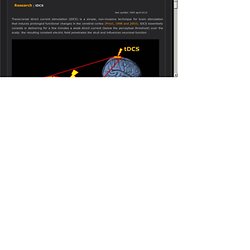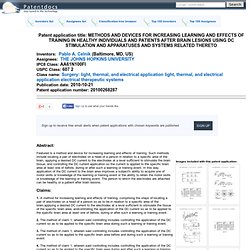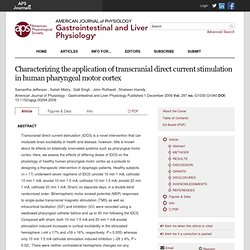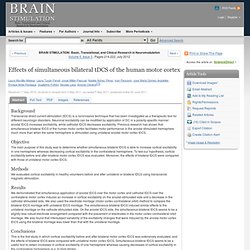

Down-Regulation of Negative Emotional Processing by Transcranial Direct Current Stimulation: Effects of Personality Characteristics. Task-Specific Effects of tDCS-Induced Cortical Excitability Changes on Cognitive and Motor Sequence Set Shifting Performance. Polarity-Dependent Transcranial Direct Current Stimulation Effects on Central Auditory Processing. Transcranial Direct Current Stimulation Augments Perceptual Sensitivity and 24-Hour Retention in a Complex Threat Detection Task. BrodmannMontageKaiser-v2.
Optimal transcranial magnetic stimulation coil placement for targeting the dorsolateral prefrontal cortex using novel magnetic resonance image?guided neuronavigation. CorticalCartography3. Electrode Positioning and Montage in Transcranial Direct Current Stimulation. Transcranial direct current stimulation (tDCS) is an established technique to modulate cortical excitability1,2.

It has been used as an investigative tool in neuroscience due to its effects on cortical plasticity, easy operation, and safe profile. One area that tDCS has been showing encouraging results is pain alleviation 3-5. Date Published: 5/23/2011, Issue 51; doi: 10.3791/2744 Keywords: Neuroscience, Issue 51, Transcranial direct current stimulation, pain, chronic pain, noninvasive brain stimulation, neuromodulation DaSilva, A.
Transcranial direct current stimulation (tDCS) is a technique that has been intensively investigated in the past decade as this method offers a non-invasive and safe alternative to change cortical excitability2. 1. Check if you have all materials needed (Table 1, Figure 1). 2. Make sure the subject is seated comfortably. 3. Inspect the skin for any pre-exiting irritation, cuts, or lesions - avoid stimulating over damaged skin and over skull lesions. 4. 5. tDCS informed consent video. Electrode Positioning and Montage in Transcranial Direct Current Stimulation.
Thesis_final. MeraSBarr_OptimalTranscranialMagnetic. SKIL Introduction to Brodmann area functions. Newronika. Last update: 30th april 2010 Transcranial direct current stimulation (tDCS) is a simple, non-invasive technique for brain stimulation that induces prolonged functional changes in the cerebral cortex (Priori, 1998 and 2003). tDCS essentially consists in delivering for a few minutes a weak direct current (below the perceptual threshold) over the scalp: the resulting constant electric field penetrates the skull and influences neuronal function .

Figure 3 – tDCS: the electrical field penetrating into the scalp induces changes in brain excitability. Currently, tDCS is being studied for the treatment of a number of clinical conditions including: Brain Stimulation Review - tDCS - State of Art. METHODS AND DEVICES FOR INCREASING LEARNING AND EFFECTS OF TRAINING IN HEALTHY INDIVIDUALS AND PATIENTS AFTER BRAIN LESIONS USING DC STIMULATION AND APPARATUSES AND SYSTEMS RELATED THERETO. Abstract: Featured is a method and device for increasing learning and effects of training.

Such methods include locating a pair of electrodes on a head of a person in relation to a specific area of the brain, applying a desired DC current to the electrodes at a level sufficient to stimulate the brain tissue; and controlling the DC current application so the current is applied to the specific brain area at least one of before, during or after such a learning or training event. In this way, application of the DC current to the brain area improves a subject's ability to acquire one of motor skills or knowledge of the learning or training event or the ability to retain the motor skills or knowledge of the learning or training event. The person to which the electrodes are attached can be healthy or a patient after brain lesions. Transcranial direct current stimulation impr... [J Cogn Neurosci. 2011. Characterizing the application of transcranial direct current stimulation in human pharyngeal motor cortex.
Abstract Transcranial direct current stimulation (tDCS) is a novel intervention that can modulate brain excitability in health and disease; however, little is known about its effects on bilaterally innervated systems such as pharyngeal motor cortex.

Here, we assess the effects of differing doses of tDCS on the physiology of healthy human pharyngeal motor cortex as a prelude to designing a therapeutic intervention in dysphagic patients. Healthy subjects (n = 17) underwent seven regimens of tDCS (anodal 10 min 1 mA, cathodal 10 min 1 mA, anodal 10 min 1.5 mA, cathodal 10 min 1.5 mA, anodal 20 min 1 mA, cathodal 20 min 1 mA, Sham) on separate days, in a double blind randomized order. Cerebral Cortex Functions. Facilitate Insight by Non-Invasive Brain Stimulation. Enhancement of Planning Ability by Transcranial Direct Current Stimulation. Introduction Patients with frontal lobe pathology, such as schizophrenia, depression, and lesions, commonly express executive function impairment.

Planning abilities are prerequisites for successful problem solving and effective behavior. The Tower of London (TOL) is a widely used test of planning ability (Shallice, 1982), and is established as a valid measure for cognitive skill acquisition (Peretti et al., 2002). Patient performance, particularly at higher levels of task load, differs from healthy controls and relates to findings in neuroimaging studies concerning the dorsolateral prefrontal cortex (DLPFC) as the most critical structure for solving the TOL task (Baker et al., 1996; Owen, 1997; Dagher et al., 1999; Rainville et al., 2002; Lazeron et al., 2004; Rasser et al., 2005; van den Heuvel et al., 2005). We aimed to evaluate the influence of tDCS on frontal lobe function by use of the TOL test. Results None of the participants experienced adverse side effects.
Reaction time. Rethinking the thinking cap. Brain Stimulation - Effects of simultaneous bilateral tDCS of the human motor cortex. Received 17 May 2010; received in revised form 3 May 2011; accepted 5 May 2011. published online 02 June 2011.

Background. Dual-hemisphere tDCS facilitates greater improvements for healthy subjects' non-dominant hand compared to uni-hemisphere stimulation. All 16 participants completed the experimental procedures.

Data for the three stimulation conditions are shown in Figure 1. The values for the dependent variable for the three stimulation conditions were the following: sham (mean = .12, SEM = .03), uni-hemisphere (mean = .16, SEM = .02), dual-hemisphere (mean = .24, s.e.m. = .04). A repeated measures ANOVA yielded a significant within-subjects effect of tDCS condition (F(2,14) = 4.468, p = .037). Prefrontal cortex transcranial direct current stimu... [Appetite. 2011. When anger leads to aggression: ind... [Soc Cogn Affect Neurosci. 2012. Activation of inhibition: diminishing impuls... [J Cogn Neurosci. 2011. Modulating inhibitory control with direct current... [Neuroimage. 2011. Transcranial direct current stimulation over Br... [Neuroscience. 2011. Behavioural facilitation following brai... [Neuropsychol Rehabil. 2011. Improving working memory: exploring the ef... [Clin Neurophysiol. 2011. Transcranial direct current stimulation's effe... [Exp Brain Res. 2011.
Transcranial electrical stimulation (tE... [Neuropsychol Rehabil. 2011. Speech facilitation by left inferior frontal corte... [Curr Biol. 2011. Transcranial direct current stimulation (tDCS) ... [Brain Stimul. 2011. Modulating the brain at work using noninvasive tr... [Neuroimage. 2012. Sadleir%20et%20al_tDCS_Predicted%20current%20densities%20in%20a%20realistic%20head%20model_ANA_poster_2009.